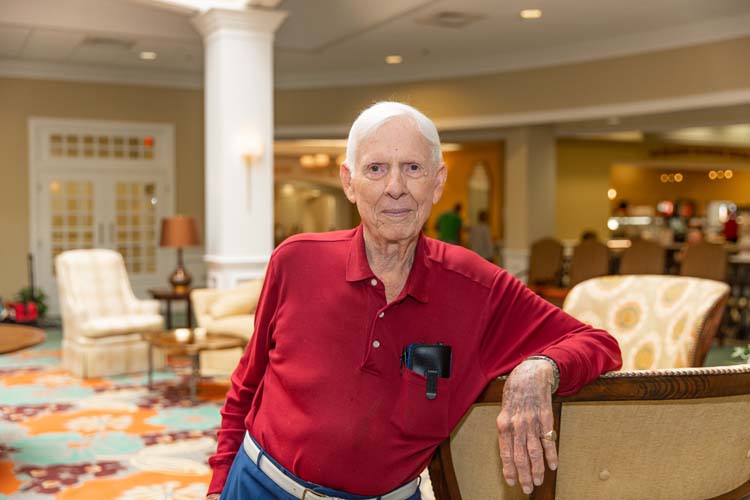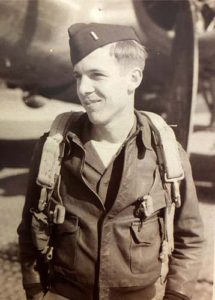
Each Memorial Day, Vero Beach resident Philip Moyer, a former World War II B-17 bomber pilot and decorated war hero, joins fellow Americans as they pause in recognition of the men and women who have lost their lives in service to our nation.
 Unlike so many of his comrades-in-arms who made the ultimate sacrifice to secure the freedoms we enjoy, Moyer, who flew 35 missions in the European theater, was one of the lucky ones. At the age of 94 he is a walking, talking timeline of events chronicled over the past century that have shaped the country.
Unlike so many of his comrades-in-arms who made the ultimate sacrifice to secure the freedoms we enjoy, Moyer, who flew 35 missions in the European theater, was one of the lucky ones. At the age of 94 he is a walking, talking timeline of events chronicled over the past century that have shaped the country.
Moyer was born in Doylestown, Pa., in 1924, just before the start of the Great Depression. One of four boys, he grew up in a bucolic setting, digging for worms in the greenhouses where his father grew roses and daydreaming about flying.
“When I was a kid I would go to the local airport to watch the planes and built model airplanes. I really wanted to fly.”
After being called up for service, he initially intended to enlist in the Navy, impressed by the snappy epaulet-adorned uniform of a neighbor.
“He looked like the cat’s meow,” says Moyer. Realizing that as a poor swimmer, the Navy might not be the best choice for him, he recalls, “I envisioned myself floating around in the Pacific and I said, ‘Oh no.’ I changed my mind and went over to the Air Corps.”
As with many veterans, he is somewhat reticent to talk about his time in the military, ruefully remembering that there was a high casualty rate among pilots.
After the war, Moyer took advantage of the opportunity to attend college; graduating from Lehigh University with an engineering degree. He would later return to school to become an architect.
“I studied civil engineering because I never wanted to work inside,” Moyer says.
Although no longer in the military, his new career was rife with governmental projects. One of his first was at the Pinetree Radar Site developing the DEW Line, the first Aircraft Control and Warning Station built, which eventually ranged from Newfoundland, Labrador to Alaska.
“This was the first line of defense to warn of an invasion,” explains Moyer. “During the Cold War, they were concerned the Russians would attack by air, approaching North America over the North Pole.”
Other government projects followed, among them jet bomber design upgrades, NATO air bases, a U.S. Navy radio antenna,a 600-foot U.S. Navy radio antenna, an armored division cantonment.
According to Moyer, his most significant project was the design and construction of the Vehicle Assembly Building, the largest single-story building in the world. Located at NASA’s Kennedy Space Center at Cape Canaveral, the building was built to house the Saturn V rocket for the 1960’s Apollo program.
In an April 24, 1965 – Saturday Evening Post article, journalist James Atwater described the building as: “A cosmic room to stagger the mind. Far and away the mightiest structure in the world, the Apollo project’s VAB has doors big enough to admit skyscrapers, a room so vast that it could breed its own weather.”
The VAB, arguably Cape Canaveral’s most iconic building, is still an integral part of ongoing research and space exploration at the Kennedy Space Center. His group also constructed the launch control center buildings before the program was moved to Houston.
“The VAB was the most challenging project I worked on. Kennedy said ‘We’re going to the moon by 1970.’ If we had flunked out on that job, we probably would have never gotten another job.”
Chuckling, Moyer adds, “Even the model of the building was huge at 12 feet in height. I had trouble carrying it around.”
The undertaking was as massive as the structure itself, involving a multi-agency task force which Moyer oversaw; he spent a great deal of time traveling between New York and Florida.
“My first visit to the Cape was in a jeep with a captain from the Jacksonville District of the Army Corps of Engineers. He took me out and showed me Cape Canaveral. It was a jungle; there was nothing there but an eagle’s nest. We worked night and day toward the end to have everything ready. Then our job was finished and it was time for the astronauts to take over.”
Moyer recalls anxiously following the progress of the first shuttle launch, listening to the radio from his office in New York, but notes that there were more failures than success with spaceflight in the early years.
His own passion for flying was never far away and, after eventually retiring and making his way to Vero Beach, he joined three flying clubs: the Experimental Aircraft Association, Florida Aero Club and the Quiet Birdmen.
It was through these affiliations that earlier this year, Moyer made a pilgrimage to Washington, D.C. as part of the Southeast Florida Honor Flight, which applauds the actions of military veterans by conveying them to Washington to visit memorials honoring their service and sacrifices.
“The Honor Flight was an incredible experience; I am ecstatic that the flying club thought of me,” says Moyer, whose previous visits had been to appraise monuments from an architectural standpoint. “It was very interesting to me to get to see all of them again at this stage in my life.”
Moved by the trip and the number of people interested enough to volunteer their time to make it happen, he says, “the American people need to have a deeper appreciation for those that built this country and the Honor Flight gives veterans and civilians the chance to express themselves.”
Brian Becker met and bonded with Moyer through their love of flying and accompanied him on the trip, where they were met by a cheering crowd at the airport and received a full police escort into Washington, D.C.
“It’s a part of history that we tend to gloss over. Our lives are so fast. We don’t take enough time to reflect back on our forefathers, grandfathers and the people who made a difference,” says Becker. “Driving up the hill to Arlington and the Tomb of the Unknown Soldier, there are thousands of white tombstones as far as you can see. It gives you an appreciation for the magnitude and the cost in lives.”
“We don’t emphasize what happened in the war and I think everyone should have a much greater appreciation about what these people went through. It’s easy for guys like me to sit around and talk about it but to me, to give your life, to stop living because of a war, there’s no greater sacrifice,” stresses Moyer.
The Southeast Florida Honor Flights include visits to the World War II Memorial, Marine Corps Iwo Jima Memorial, Arlington National Cemetery, Korean War Memorial, Vietnam War Memorial, Air Force Memorial, Pentagon 9/11 Memorial, Tomb of the Unknown Soldier, and Navy Yard and Navy Museum.



